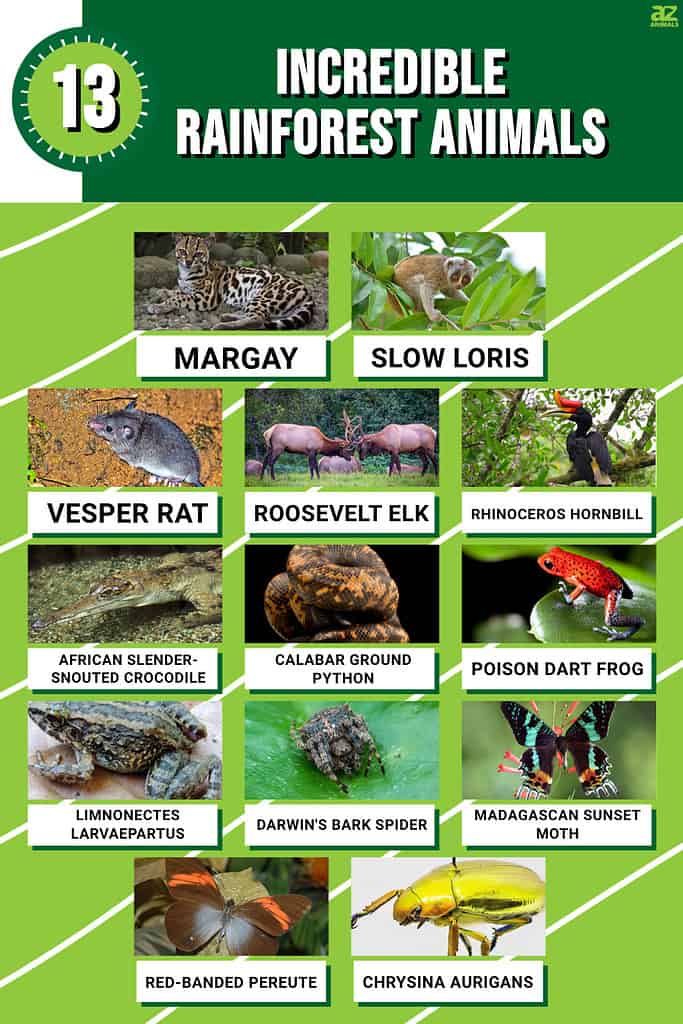
A rainforest, whether tropical or temperate, is described as a mostly evergreen forest that gets between 80 and 400 inches of rain a year. The variety of plant and animal life is breathtaking, even though these forests cover only 6 percent of the earth’s surface. Animals and plants are constantly being discovered, while at the same time, many of the rainforest’s lifeforms are endangered due to human activity. This article lists 13 of some of the most incredible animals that live in the rainforest.
13. Incredible Rainforest Animals: Chrysina aurigans
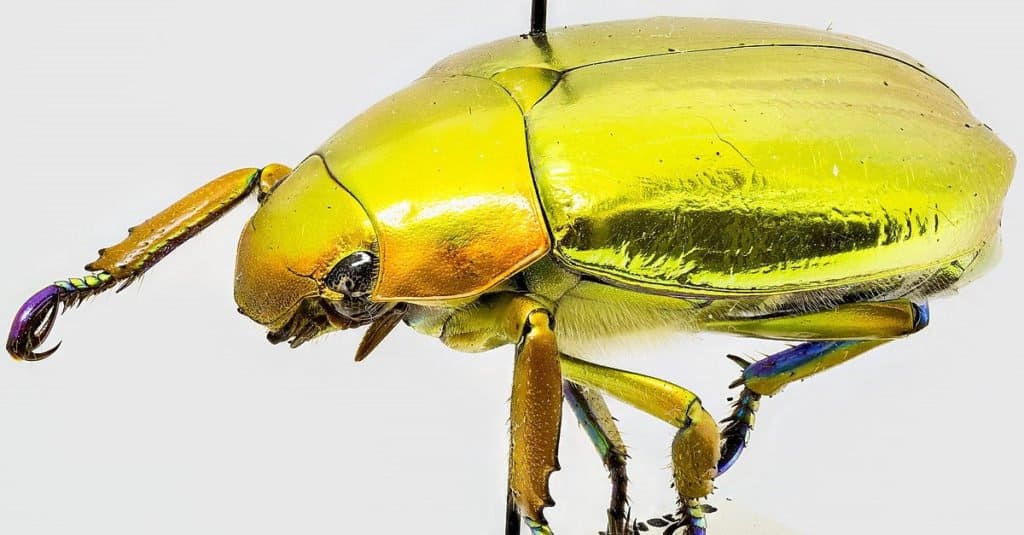
Chrysina beetles are also called “jewel” scarabs, because, in addition to the gold and silver species, many are emerald green, with some spectacular species having combinations of green, gold, and silver.
©Brett Forsyth from Geulph, Canada / CC BY 2.0 – License
Found in the rainforests of Costa Rica, this scarab beetle glimmers like a nugget of gold. But the beetle’s tough exoskeleton isn’t made of gold but chitin, the same stuff that makes up the carapace of the reviled cockroach. Like the blue in a butterfly’s wings or a bird’s feather, Chrysina aurigans’ shimmering gold color is a trick of the light that helps hide it from predators. This astonishing beetle is between 0.63 and 1.375 inches long. Another beetle, Chrysina limbata is almost identical but is a scintillating silver.
12. Incredible Rainforest Animals: Red-Banded Pereute

This butterfly has a beautiful combination of black, red, blue-gray, and white body markings.
©Pereute leucodrosime. (2021, February 16). In Wikipedia / https://creativecommons.org/licenses/by-sa/4.0/ – License
This butterfly, found in the tropical rainforests of Central and South America, is mid-sized for a butterfly with a 2.25 to 2.35-inch wingspan. It makes up for its size with its fantastic coloration. It is mostly black but has bands of brilliant red on its forewings and blue-gray patches that spread from the bottom of its forewings to the upper part of its hindwings. The hair on the insect’s body is also bluish-gray, and the undersides of the hindwings have red spots at the base. The antennae are long, white, and end in bulbs.
11. Incredible Rainforest Animals: Madagascan Sunset Moth
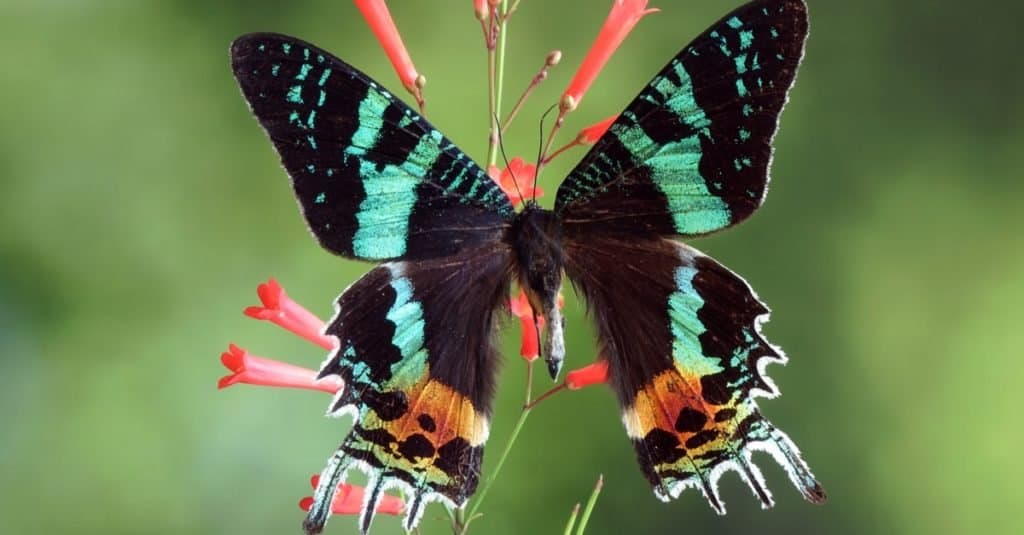
the world’s most impressive colorful,
and beautiful moth with iridescent parts in the wings.©Mark Brandon/Shutterstock.com
This large moth with a 3.25 to 4-inch wingspan is considered the most spectacular of the world’s moths. It was once mistaken for a butterfly and indeed flies during the day and resembles a swallowtail but has the robust and furry body associated with moths. Its wings are patterned with iridescent blacks, greens, blues, oranges, and yellows. Like Chrysina aurigans, its colors are mostly caused by an optical illusion and not from pigment. Endemic to Madagascar, the moth feeds exclusively on the Omphalea plant, which is toxic and passes its toxins on to the caterpillar and then the adult moth.
10. Incredible Rainforest Animals: Darwin’s Bark Spider
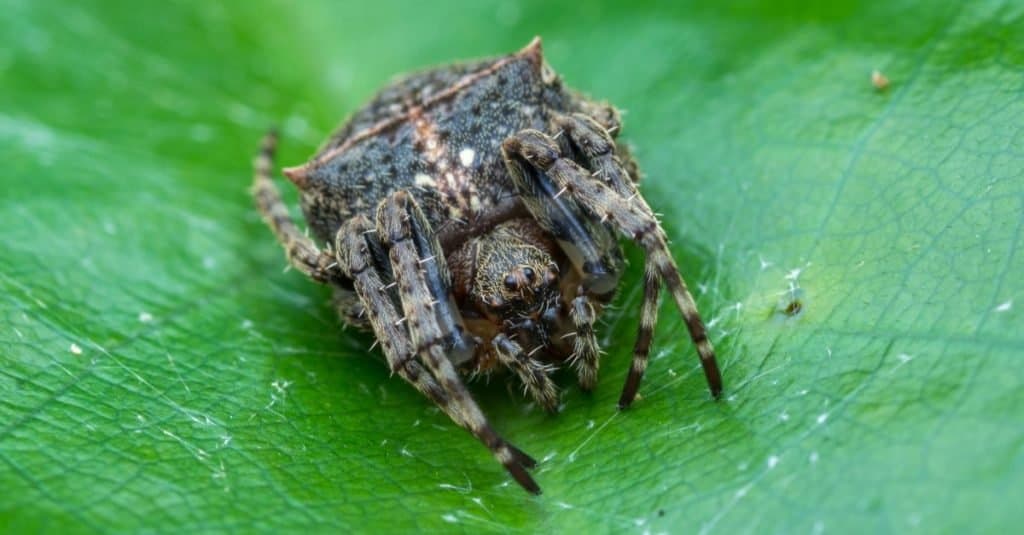
green leaf (Caerostris-darwini). The web of Darwin’s bark spider is remarkable in that it is not only the longest spanning web ever observed but is the largest orb web ever seen, at an area of up to 2.8 square meters
(30 sq ft).©Elmanther Lee/Shutterstock.com
This spider, also native to Madagascar, would give Shelob pause. Not because of the size of the spider itself, whose females are 0.7 to 0.9 inches long and whose males are much smaller, but because of the size and strength of its web. The silk of this spider is tougher than Kevlar, and its orb-shaped web can be 30 square feet around. The bridge lines, which are the foundations of the web, can be 82 feet long. The spider cleverly spins this web over bodies of water, thus taking advantage of areas that other spiders avoid. Insects such as mayflies, which hatch out of the water, simply fly up into it.
The spider itself is sort of typical. The females are black with white hair and the males are brown and red with the same areas of white. Discovered only in 2009, Darwin’s bark spider can be found in Andasibe-Mantadia National Park.
9. Incredible Rainforest Animals: Limnonectes larvaepartus
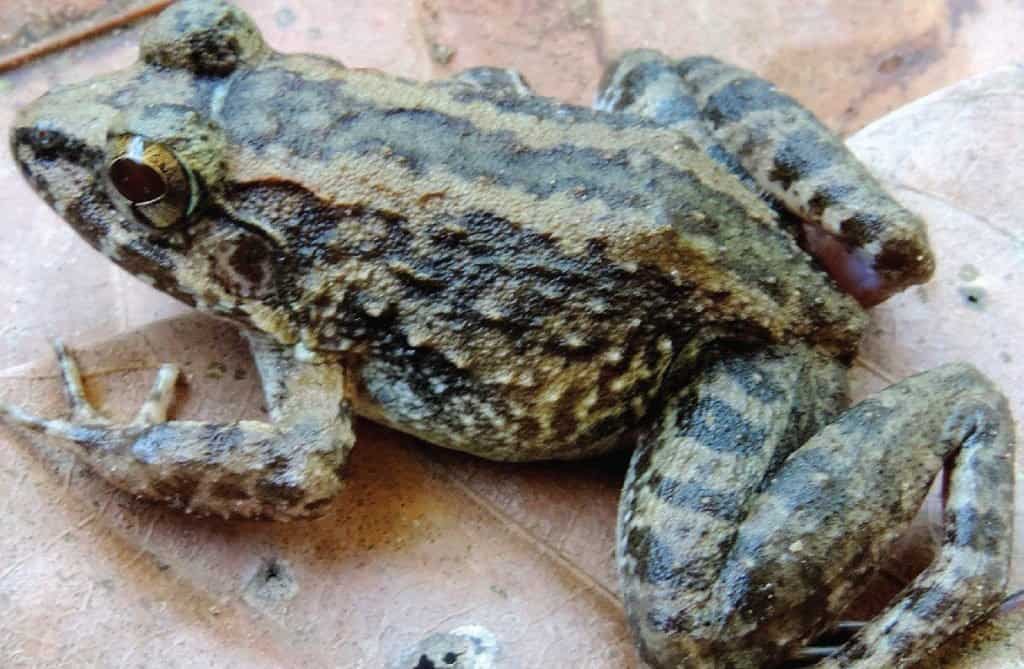
©Mirza D. Kusrini, Jodi J. L. Rowley, Luna R. Khairunnisa, Glenn M. Shea, Ronald Altig / CC BY 2.5 – License
Found in the rainforests of Sulawesi, this fanged frog gives birth to live tadpoles. It is the only frog in the world that does this. Most frogs lay eggs or give birth to tiny frogs, but for some reason the eggs of this frog hatch inside the mother’s body and emerge as tadpoles. Scientists assume that fertilization is internal, but they have no idea how this is accomplished.
Limnonectes larvaepartus is a little over an inch long from snout to vent and comes in shades of brown and gray with a pale belly. It lives near swift streams under rocks or vegetation.
8. Incredible Rainforest Animals: Poison Dart Frogs
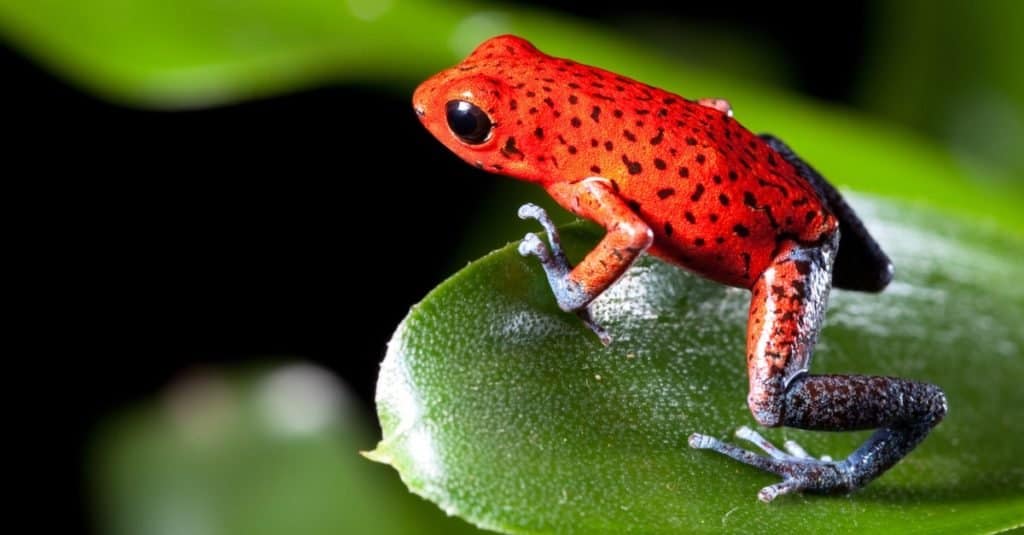
©Dirk Ercken/Shutterstock.com
These frogs, members of the Dendrobatidae family, are found in the tropical rainforests of Central and South America. Brilliantly colored, they come in bold shades of blue, red, yellow, and orange. Some, such as the golden poison dart frog, are so toxic that it’s dangerous to even handle them, while others have little or no toxicity at all. Many species of these little frogs are threatened due to habitat destruction.
Some species of poison dart frogs are also known for their unusual reproductive strategy. When their tadpoles hatch, they carry them, one at a time, piggyback, up to the canopy of the forest. There, they drop the tadpoles into the water in the “tank” of bromeliads that grow on the trees. The mother will even lay some infertile eggs in the water for the tadpoles to eat.
7. Incredible Rainforest Animals: Calabar Ground Python

The Calabar ground python is an African member of the Calabaria genus that eats rodents.
©reptiles4all/Shutterstock.com
This little python, which only grows to about 3 feet in length, is found in the rainforests of west and central Africa. It is the only member of the Calabaria genus. It is a burrowing snake that searches underground and through the leaf litter searching for prey, which is mostly small rodents. The python isn’t above waiting until a mother rodent leaves its den, then slithering in and eating the babies.
The Calabar ground python is docile and non-venomous, and when it’s threatened it just curls up into a ball and freezes. Its body is covered with smooth scales, and it has a blunt head and a short tail. What’s interesting about this python is that as it moves it keeps its head down and raises and wiggles its tail. This may trick would-be predators into thinking that its back end is its front end.
6. Incredible Rainforest Animals: African slender-snouted Crocodile
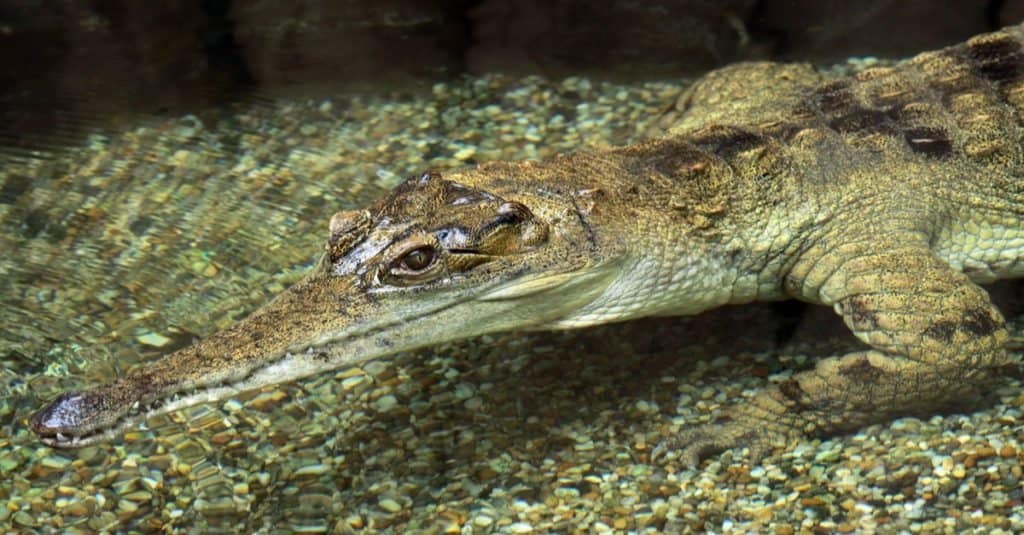
©Michal Sloviak/Shutterstock.com
This crocodile is found around the freshwater or brackish bodies of water that runs through the rainforests of central Africa. It is a small crocodile that usually grows no more than 13 feet, with males being bigger than females. Like other crocodilians, it has scutes over its hide, but it can be told from its relatives by its long and slender snout. Like all crocodilians, it lays eggs, and the temperature of the incubating material determines the sex of the hatchlings.
5. Incredible Rainforest Animals: Rhinoceros Hornbill
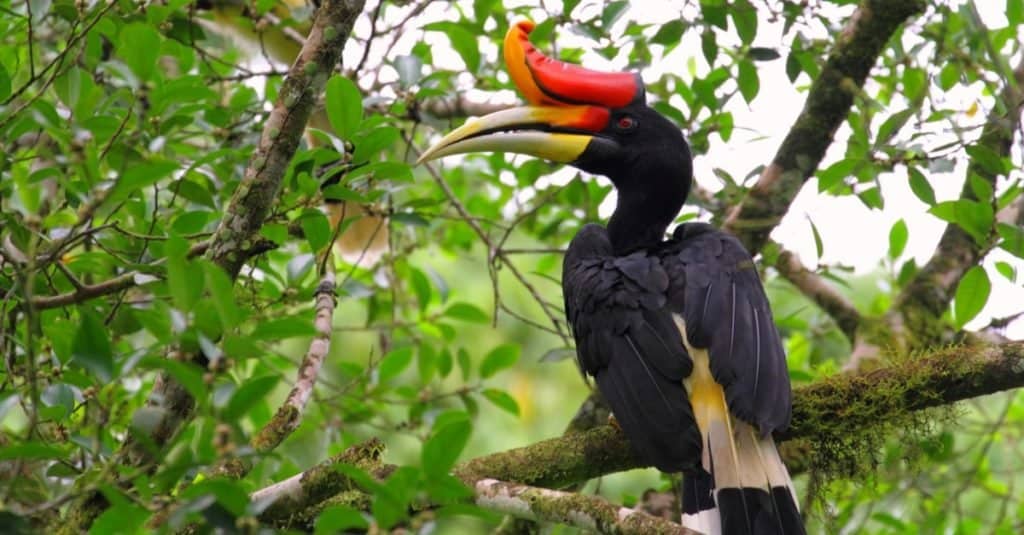
©YUMIK/Shutterstock.com
This robust bird is Malaysia’s national bird and the state bird of Sarawak and is found around Indonesia and the south of Thailand. It is one of the largest hornbills and is notable for the huge casque atop its head. The casque is almost as long as the bird’s bill curves up at the end and is orange or red. The rest of the bird is mostly black, though the white tail and rump can be seen when the bird flies. The birds are between 31 and 35 inches long, and males are bigger than females.
The rhinoceros hornbill’s reproductive strategy is interesting. At one point, the female and the chicks are walled into a tree cavity by the male. There’s only a hole just big enough for the male to feed the female and for her to relieve herself. When the chicks are ready to fly, the parents break down the wall, which is made out of mud, to let them out.
4. Incredible Rainforest Animals: Roosevelt Elk
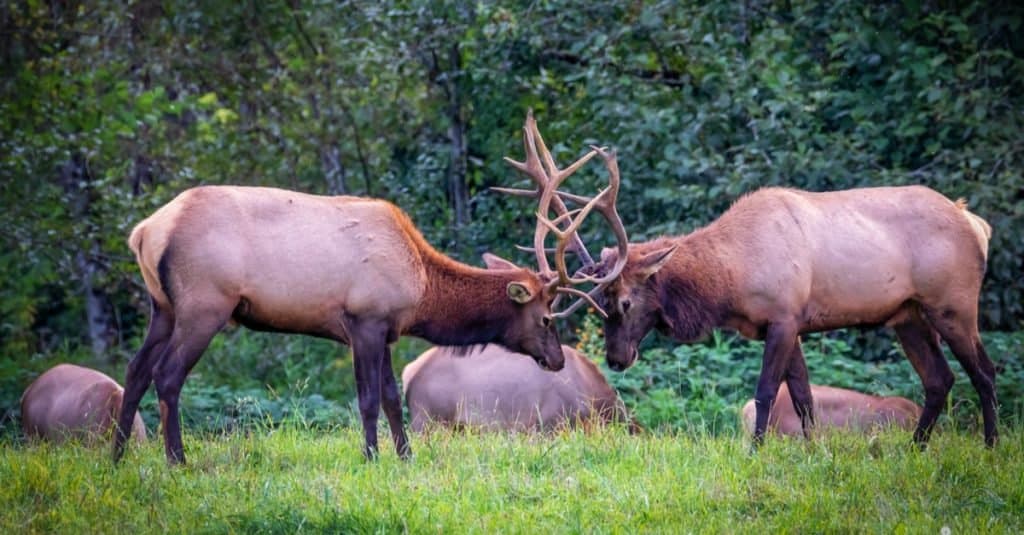
©Mark A Lee/Shutterstock.com
The Roosevelt elk is the largest elk in North America and is found in the Pacific Northwest’s temperate rainforests, including Olympic National Park.
This large deer can grow 10 feet long, stand as much as 5.6 feet high at the shoulder and weigh between 700 and 1100 pounds. The cows are smaller and lighter. During the summer the elk eat grass and sedges, and in the winter it eats berries, young conifers such as the Douglas fir, and fungi such as mushrooms and lichens.
3. Incredible Rainforest Animals: Vesper Rat

©iStock.com/Alberto Carrera
This little rodent, with a body length of 4.25 to 5 inches and a tail that’s about the same length, lives in the tropical rainforests of Mexico and Central America. It lives colonially in trees in nests made out of leaves, twigs, and other vegetation. Its big toe looks like an opposable thumb and helps it grip branches. Its upper parts are pinkish-brown with dark hair on its back, and its belly is white. This nocturnal rat eats figs and avocados.
2. Incredible Rainforest Animals: Slow Loris
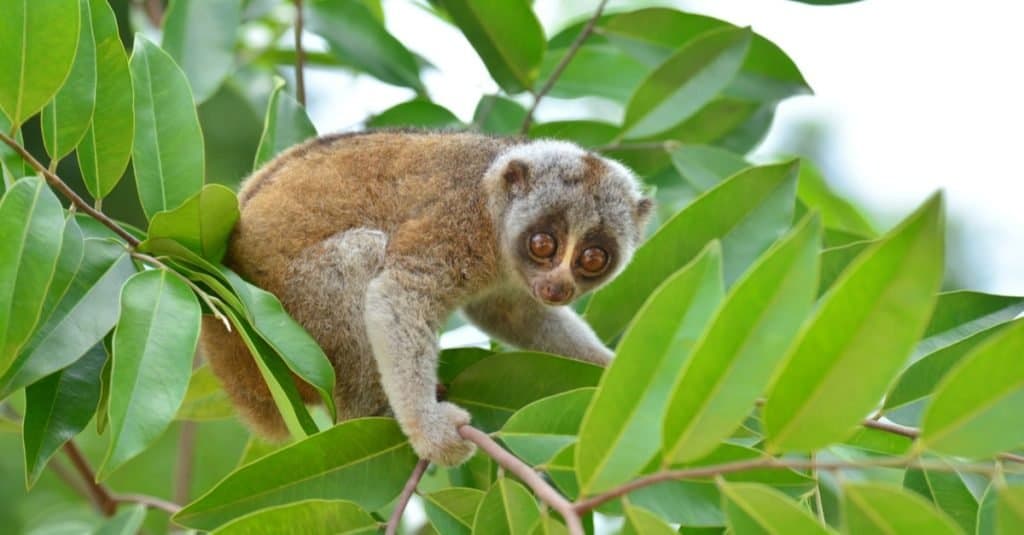
a cute primate on the
branch of tropical forest in South East Asia. Slow lorises have a toxic bite, a trait rare among mammals and unique among primates.©Conservationist/Shutterstock.com
The slow loris is a primate that lives in the rainforest of south and southeast Asia. It is different from just about every other primate due to its slow and deliberate movements. It has a round head, short ears, and enormous eyes, and its fur ranges from reddish-brown to grayish-brown It has a brown stripe that runs from the top of its head to its back or its tail. Its opposable thumbs, prehensile feet, and binocular vision evolved to suit its life in the trees.
Don’t let its slow movements fool you. A slow loris may sit motionless for hours watching for live prey, but once it spots supper, it can quickly pounce on insects, birds, or small mammals. The slow loris can also create venom when the act of licking a toxic gland in its armpit is combined with its own saliva. The venom is administered through a vicious bite.
1. Incredible Rainforest Animals: Margay
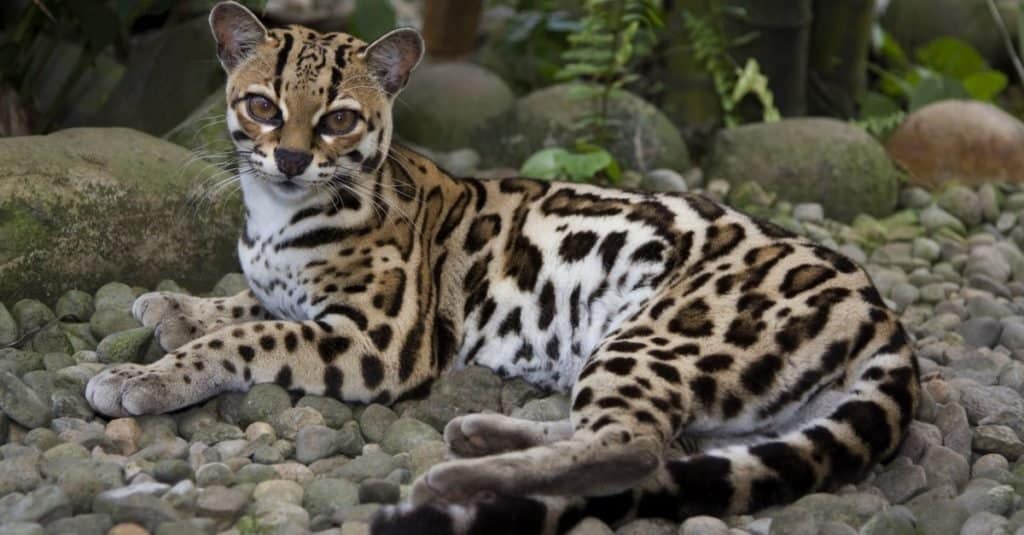
©Jeff Grabert/Shutterstock.com
The margay is one of the smaller of the wild cats and is found in the tropical rain forests of southern Mexico, Central America, and much of South America. A solitary cat that’s at home in the trees, has hind feet that can rotate 180 degrees, much like a squirrel’s. This allows the margay to climb down tree trunks headfirst. Its fur is full of dark spots with light centers much like its cousin the ocelot, but it differs from the ocelot in that it’s smaller and has a much longer tail in proportion to its body. Its body length is between 21 and 31 inches long, and it weighs between 3.5 and 8.25 pounds.
Summary of the Top 13 Incredible Rainforest Animals
| Rank | Rainforest Animal |
|---|---|
| 1 | Margay |
| 2 | Slow Loris |
| 3 | Vesper Rat |
| 4 | Roosevelt Elk |
| 5 | Rhinoceros Hornbill |
| 6 | African Slender-snouted Crocodile |
| 7 | Calabar Ground Python |
| 8 | Poison Dart Frogs |
| 9 | Limnonectes larvaepartus Frog |
| 10 | Darwin’s Bark Spider |
| 11 | Madagascan Sunset Moth |
| 12 | Red-Banded Pereute |
| 13 | Chrysina aurigans Scarab Beetle |
The photo featured at the top of this post is © Saad315/Shutterstock.com
Thank you for reading! Have some feedback for us? Contact the AZ Animals editorial team.






